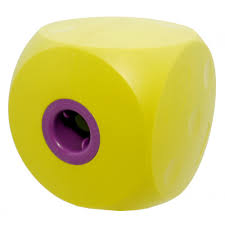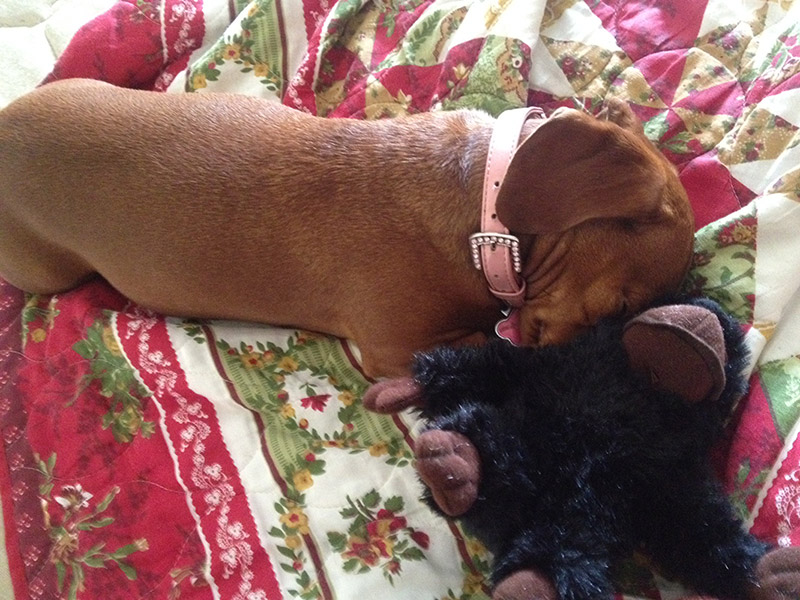- Dogs who get into trouble when left alone often do so because they’re bored. Bored dogs can be destructive, anxious, loud, and even annoying. Some dogs just seem sad without a companion. Toys can help.
- Dogs with high exercise requirements can sometimes be worked out with toys when you’re too tired to run.
- Some dogs don’t seem to understand or appreciate toys. Wouldn’t it be nice to encourage play with them?
- People who start puppies with toys early, or who have dogs with a high drive for toys, can use access to toys in lieu of or in addition to food for training.
TOY RULES ❦
Make sure you know how much supervision your dog needs with the toy. Some dogs can have stuffed toys all over the house all day long and never get into trouble. Other dogs chomp up the most destruction-proof item and choke on it in seconds while sitting in your lap. Know Your Dog & Be Safe.
I avoid toys from countries that produce tons of items on the cheap and have few regulations. Toys made in the US become more popular and plentiful every day and they are what I prefer. For that matter, toys don’t have to be bought. Be creative! An old tube sock with a big knot can be lots of fun.
Know your dog and her play-style. Some dogs love to gnaw wood things, others shred paper, others strangle stuffed toys, etc. Pick the right toy to get your dog excited and one that won’t put her in unnecessary danger.
Avoid playing tug games with dogs who get too worked up for you to control. Work with a trainer to teach your dog to stop play on command first!
USING TOYS TO ENRICH YOUR DOG’S LIFE
Dogs need more than physical exercise, they need mental stimulation as well. Can you imagine being locked in a room all day with nothing to read, no computer to use, and no tv to watch? OK sounds like fun for those of us who are overstimulated by our multi-media lifestyles but we’d get bored too after a few days.
If your dog doesn’t read—don’t stress out, mine don’t either—you can engage his mind with interactive toys. Nina Ottosson,http://www.nina-ottosson.com, has made creating quality toys her mission. Some local stores carry her toys, such as Crossroad’s Pets http://crossroadscampus.org/shop-adopt.
 One of the oldest interactive toys is a Kong. These hard to destroy rubber toys can be stuffed with tasty stuff, even frozen, for your dog to dig or lick out and enjoy. Google “Kong Stuffing” for ideas. I personally would avoid the processed Kong treats in favor of real food, single ingredient items like frozen broth, cheese, and cooked meat.
One of the oldest interactive toys is a Kong. These hard to destroy rubber toys can be stuffed with tasty stuff, even frozen, for your dog to dig or lick out and enjoy. Google “Kong Stuffing” for ideas. I personally would avoid the processed Kong treats in favor of real food, single ingredient items like frozen broth, cheese, and cooked meat.
Treat balls come in all shapes, sizes, and difficulty. The dog moves the ball around so kibble will fall out to eat. Feeding a dog meals this way can make eating more of a hunting experience and life less boring. I prefer the hard plastic ones that are easy to take apart to clean though they can make quite a racket rolling around. This yellow treat cube is for an advanced hunter!
Teach your dog to differentiate between toys by name or other cue so you can send him to the toy box for some fun.
 Use stay to teach hide-and-go-seek games with your dog using toys or yourself. CAUTION avoid hiding toys in a way that might encourage future unwelcome destruction by your dog… such as tearing up couch cushions in the search for toys.
Use stay to teach hide-and-go-seek games with your dog using toys or yourself. CAUTION avoid hiding toys in a way that might encourage future unwelcome destruction by your dog… such as tearing up couch cushions in the search for toys.
Hiding things works while you’re gone too–practice while you’re home first to make sure you’ve thought through potential problems. Hide toys and stuffed Kongs in different locations in the yard or house while your dog sits in stay or is out to potty. Then give a cue to release her to seek those things. If you play this game often your dog will know what to do and will spend time finding the fun stuff you’ve hidden for her instead of stressing out about your departure.
Create a sand box pit for digging up toys you’ve hidden. This tactic can help exhaust an otherwise indiscriminate digger but you may not want to start this behavior otherwise if it might lead to digging up your yard for the first time… know your dog. BTW putting the dog’s feces in other holes can discourage digging in that spot. Fill it in later after your dog gets the point.
EXERCISING FIDO WITH YOUR FEET UP
Teach your dog to fetch and encourage physical exercise by tossing the ball from your lawn chair or hammock. CAUTIONavoid fetch games with a dog who obsessively retrieves. Believe it or not, fetching until you drop is NOT ideal
Teach your dog to ID toys by name and challenge your dog to bring you different things. You can hide them when you get home while you’re getting settled—this is a great way to keep your return calm*—and send your dog to look for them later while you relax on the couch. CAUTION avoid this if the last suggestion you want when you get home is to play with your dog because he may learn to initiate this game on his own.
*Making a big deal of your departures and arrivals can cause many dogs to act as if they suffer from separation anxiety. It’s best to stay calm and get excited/worked up randomly, instead of connecting excitement to your comings/goings.
Play hide-and-go-seek by putting your dog in stay while you hide in the closet or other remote location and wait—with a good book or tablet—for your dog to find you.
TEACHING A DOG TO PLAY WITH YOU
If you’ve ever adopted a dog who seems never to have learned to play you know what I’m taking about! Most often developing a relationship and trust eventually releases the inner puppy to play. I’ve adopted/fostered dogs who took a year to start playing but most dogs settle in within weeks of months. Be patient.
Try group training classes and spending lots of low-key time together to develop the bond between you. If you notice something tends to scare your dog, such as moving past your feet or loud noises, encourage your dog to work through the fear while being careful not to aggravate it. Coddling some behaviors in dogs can make them worse.
Remember to watch the body language of these dogs to see if your attention is really appreciated. If you are handling in a way the dog finds intimidating or unwelcome, you’ll never develop the bond you seek.
Try sitting on the floor with treats and encouraging different behaviors. You can click/treat, or otherwise reward, anything you would like the dog to do again; for example: hitting a toy with feet, mouthing a toy, pushing it with the nose, jumping on it, rolling on it, etc. Check out our article on clicker training for help getting started or enroll in a local group class to learn more.

